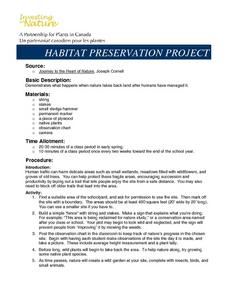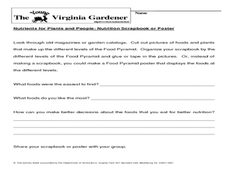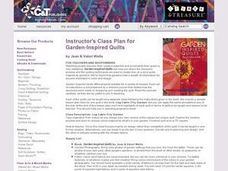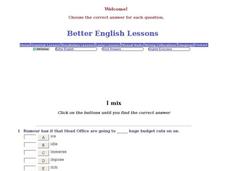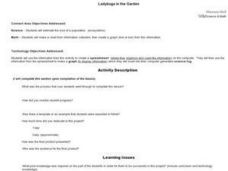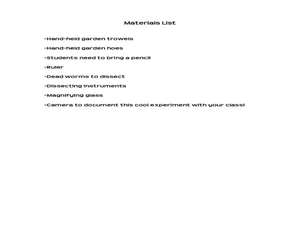Curated OER
Habitat Preservation Project
Students demonstrate what happens when nature takes back land after humans have managed it. They find an area in the schoolyard, and mark it off with a boundary. Students build a simple fence with string and stakes. They put up a sign...
Curated OER
The Changing Me
Third graders study the human body. In this health lesson, 3rd graders discuss that everyone's body is growing, measure body parts using a tape measure, and color the body worksheet.
Curated OER
Word Identification
Students identify grocery items using words on a list. In this grocery word identification lesson, students use a grocery list to choose items from simulated grocery store shelves in their classroom. They work in groups to simulate a...
Curated OER
Nutrients for Plants and People: Nutrition Scrapbook or Poster
Get creative about nutrition! This crafty food project has learners thinking about the foods that make up levels of the food pyramid, first cutting out images of different types of food and plants from magazines or gardening catalogues....
Curated OER
Butterfly 1: Observing the Life Cycle of a Butterfly
Students observe and identify the characteristics of the life cycle of a butterfly.
Curated OER
A Pressing Project
Students create a collection of pressed plants. In this plant lesson, students use newspaper, plywood, and a rubberband to press plants they previously collected.
Curated OER
Black, Striped, White, & Plaid: Changing Patterns
Students create a new design for an everyday object using color and patterns after observing objects that surround them in the classroom; focusing on five examples that are either solid colored or patterned.
Curated OER
Peace Corps Challenge Game-National Trees
Students explore trees around the world. In this world geography and tree lesson, students compare familiar local trees and discuss similarities and differences. Students give opinions about why the oak tree was chosen as our national...
Curated OER
Decimals in the Garden
In this math activity, students are given pictures of garden tools and prices (in pounds). They select the items they would like to purchase for their garden and calculate the cost to buy these items. Students may use the internet to...
Curated OER
Math Maven's Mysteries: The Case of the Incredible Shrinking Garden
In these math word problem worksheets, 7th graders help solve the mystery about 'The Case of the Incredible Shrinking Garden.' Students find the new length and width measurements of the shrunken garden using the area of rectangle.
Curated OER
Garden-Inspired Quilts
Students create one-of-a-kind quilts inspired by gardens. Finished quilt size is 75" square. Inspiration and design process is the focus of creating these quilts. Lesson focuses mainly on design rather than completion of the quilt.
Curated OER
How Does Your Garden Grow?
Second graders view an animated picture book at a Web site. The picture book illustrates each step in planting and growing a garden. They design how-to books showing the process. They will draw a picture and write a caption for each step.
Curated OER
Predicting the Greening of Spring With Red Emperor Tulips
Students examine seasonal changes by watching tulip plant growth across the continent utilizing the Journey North website. They develop hypotheses as to why the plants emerge and grow where they do.
Curated OER
Color Your World with Changes --- the Camouflage Game
Seventh graders, after predicting dominant colors foud in their habitat or garden, visit heir area on a monthly basis. They search for colored toothpicks, then graph the results, determining the dominant color for the month.
Curated OER
Secrets of the Ocean Realm - In the School "Star Gardens"
High schoolers learn to use a tide table in plotting tidal curves and create a tide calendar by plotting a month-long tidal curve on an ordinary pictorial calendar.
Curated OER
Aqualung , the New Age Garden
Students examine how underwater landscape could be used for food production in the future. They discuss underwater landforms, draw a picture of an underwater landscape and a type of technology to use underwater, and write a description...
Curated OER
Don't Trust Your Eyes
Pupils brainstorm a list of possible actions that they could do to protect the water resources from pollution. They create hypotheses and conclusions by completing experiments and observing different pollutants.
Curated OER
Water Pollution Lesson Plan: Don't Trust Your Eyes
Students develop a list of actions they could perform that would protect our water resources from pollution. They formulate hypotheses, conduct experiments and draw conclusions about actual pollutants found in our water supply.
Curated OER
ESL: Words Beginning With I
In this ESL "words that begin with I" worksheet, students choose the correct word that begins with the letter I to complete a set of 20 sentences. Page has a link to additional activities.
Curated OER
Ladybugs in the Garden
Fifth graders estimate the size a population (ecosystems) Students make a chart from information collected then create a graph (line or bar) from this information. Students do a lesson where they observed, examine, and record data...
Curated OER
Vocabulary: Talking About Your Family-2
In this foreign language worksheet, students fill in the blanks for ten sentences. Each sentence is missing a word that describes a family member.
Curated OER
Sources of Heat
Fourth graders conduct an experiment related to heat sources, and participate in a heat source hunt. They identify sources of heat, then compare the melting rate of ice cubes, illustrating the results in their science journal. Students...
Curated OER
Herb, The Vegetarian Dragon
Students use the Internet. In this reading comprehension lesson, students read the story Herb, The Vegetarian Dragon and answer comprehension questions. Students use the Internet to complete other activities associated with the book.
Curated OER
A Science Trail: Worms
Third graders explore worms in multiple ways. In this lesson on worms, 3rd graders search for worms in their natural environment, record data on worms, and dissect worms.


